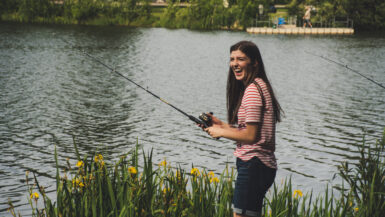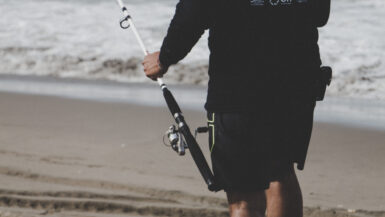Fishing is a popular pastime that can be enjoyed by people of all ages. One of the best ways to get started is by using the right lures for freshwater fishing. Whether you’re a beginner or an experienced angler, choosing the right lure is essential for successful fishing. This article provides a comprehensive guide to choosing the best lures for freshwater fishing, including the types of lures available, the best fishing locations, and tips for using the lures. With this advice, you’ll be able to choose the perfect lure for your next freshwater fishing expedition.
Types of Lures for Freshwater Fishing
Fishing jigs are a type of freshwater fishing lure that can be used to catch many species of fish. Jigs come in a variety of sizes and shapes, but typically consist of a weighted head with a trailing hook. Jigs are designed to mimic the motion of baitfish, which will attract fish and encourage them to strike. Jigging is a great technique to target active fish and can be used in a variety of water types.
Spinnerbaits
Spinnerbaits are another great type of freshwater fishing lure. These lures usually feature a weighted head and rubber skirts with a single or multiple blades. Spinnerbaits are designed to create a lot of flash and vibration in the water, which will help attract fish to the lure. Spinnerbaits can be fished in many different water types and are suitable for catching a wide variety of species.
Soft Plastics
Soft plastic lures are one of the most popular types of lures for freshwater anglers. Soft plastics come in a variety of shapes and sizes and can be used to catch a wide range of fish. Soft plastics are designed to look and move like a baitfish, and they come in a variety of colors. Soft plastics can be used to target a variety of species, including bass, crappie, and panfish.
Crankbaits
Crankbaits are another popular type of freshwater lure. These lures feature an angled bill that allows them to dive down into the water and attract fish. Crankbaits are often used to target larger species, such as bass and northern pike. They can also be used to target schooling fish, such as walleye. Crankbaits come in a variety of sizes and colors and can be used in a variety of water types.
Spoons
Spoons are a type of lure that has been used for many years by freshwater anglers. These lures are designed to move erratically through the water, which will attract fish and encourage them to strike. Spoons come in a variety of sizes and shapes, and can be used to target a range of species, including bass, walleye, and panfish.
Topwater Lures
Topwater lures are designed to float on the surface of the water and create a lot of noise and commotion. These lures come in many shapes and sizes, but they all feature an oversized hook. Topwater lures are usually used to target bass, but they can also be effective for catching other species. Topwater lures are best used in clear or shallow water, where the sound and commotion of the lure will draw in fish.
Factors to Consider When Choosing a Lure
When shopping for lures for freshwater fishing, it helps to understand the different types of lures and the situations they are best suited for. Some of the most popular and widely used lures for freshwater fishing include crankbaits, spinnerbaits, jigs, and jerkbaits. Crankbaits are usually lightweight with a single hook attached, while spinnerbaits have multiple blades attached to a weighted hook, which create flash and vibration to attract fish. Jigs are soft plastic weighted lures that are meant to mimic the movements of insects or small fish. Jerkbaits are typically hard plastic lures that are used for trolling.
Size of Lure
Size is an extremely important factor when it comes to choosing the right lure for freshwater fishing. Different types of lures come in various sizes and weights, so it is important to match the size and weight of the lure to the size of the fish you are targeting. If a lure is too large or heavy, it may not be able to attract the smaller fish in the area. Conversely, if a lure is too small or light, it may not be able to catch the larger fish you are targeting.
Color of Lure
Color is also an important consideration when choosing the right lure for freshwater fishing. Most lures come in a variety of colors, ranging from natural colors such as silver and gold to more vibrant colors such as pink and chartreuse. Different colors can be used to attract different types of fish. For example, lighter colors such as silver and white may be used to attract fish in murky waters, while brighter colors such as pink and chartreuse may be used in clearer waters to attract more aggressive fish.
Action of Lure
The action of the lure is also an important factor to consider when selecting the best one for freshwater fishing. Different lures have different types of action, such as floating, sinking, or swimming. When selecting a lure, it is important to choose one that will produce the type of action that will attract the type of fish you are targeting. For example, a floating lure may be best for targeting fish near the surface, while a sinking lure may be better for targeting fish in deeper waters.
Price of Lure
When selecting the right lure for freshwater fishing, it is also important to consider the price of the lure. Some lures can be quite expensive, while others may be more affordable. Before making a purchase, make sure to compare different lures and their prices to get the best value for your money.
Popular Lures and Their Benefits
Spinnerbait is one of the most versatile lures for freshwater fishing. It is designed to imitate a baitfish or other small prey, and is composed of a metal blade or blades, a lead head and a skirt. The blades create a buzzing action in the water, drawing in both predatory fish and smaller baitfish. Spinnerbait is an effective lure to use in shallow water, where it can be quickly and easily retrieved. Its versatility makes it a great choice for a wide range of fishing conditions, as it’s suitable for trolling, casting or drift fishing.
Crankbait: Great For Covering Large Areas
Crankbait is a great lure when you want to cover large areas of water quickly. It is designed to imitate a variety of baitfish and can be retrieved from short to long distances. Crankbait is usually constructed from hard plastic or wood and features diving lips, which allow them to dive underwater to depths of 4 to 12 feet. These lures come in a variety of colors and sizes, which allows anglers to choose the one best suited for their target fish.
Jerkbait: An Excellent Lure for Catching Bass
Jerkbaits are one of the best lures for catching bass. These lures usually consist of a soft plastic body, which is fished with a series of jerks and pauses. Jerkbaits are typically used in depths of 5 to 20 feet, and their movement can be used to mimic a variety of baitfish. Jerkbaits come in a variety of shapes, sizes and colors, and can be used to target a wide range of bass species, including smallmouth and largemouth.
Spoon Lures: Perfect For Trolling
Spoon lures are a great trolling lure, and are a great choice for targeting a variety of freshwater species, including trout, salmon and bass. These lures are designed to imitate a baitfish and are usually made from metal or plastic. Spoons come in a variety of sizes, shapes and colors, and can be fished from short to long distances. When trolling, spoon lures should be retrieved at a medium to slow speed, creating a wobbling action that imitates a struggling baitfish.
Soft Plastic: A Versatile Lure for Catching All Kinds of Fish
Soft plastic is one of the most versatile lures for freshwater fishing. These lures can be used to catch a variety of freshwater species, including bass, walleye, pike and panfish. Soft plastic lures are usually made of a soft plastic material, and can be scented or unscented. They come in a variety of shapes, sizes and colors, and can be fished in a variety of ways, including cast and retrieve, jigging and trolling.
Inline Spinners: A Great Choice for Targeting Trout and Other Fish
Inline spinners are a great choice for targeting trout and other freshwater fish. These lures can be fished from short to long distances and usually feature a metal blade, a lead head and a skirt. The spinning action of the blades attract fish by creating a buzzing sound, and can be used to imitate a small baitfish. Inline spinners come in a variety of sizes, shapes and colors, and can be used to target a variety of species.
Tips for Using Lures to Increase Your Catch
Choosing the right size lure is key to increasing your catch. The size of the lure in relation to the size of the bait fish in the local water is paramount. Lures that are too large will not mimic the motions of native bait fish, whereas lures that are too small can be overlooked by the fish. Be sure to select lures that match the size of the bait fish in the area.
Consider the Water Depth
The depth of the water you are fishing should also be taken into consideration when selecting a lure. Deeper water likely requires a larger lure, as it will have to travel farther and through thicker layers of water to attract fish. On the other hand, a shallow water situation may require a smaller lure, as the fish won’t have to travel as far to find it.
Experiment with Different Lures
Experimenting with different lures based on the type of fish you are targeting is a great way to increase your catch. Different lures are designed to mimic different movements and attract different varieties of fish, so be sure to keep a good selection of lures available to you. This will give you the greatest chance of success when fishing.
Try Different Colors and Patterns
Just as you can experiment with different lures, you can also experiment with different colors and patterns on those lures. Fish react differently to colors and patterns, so it can be beneficial to try out a few different varieties to see what works best. Bright colors and flashy patterns are often the most successful in attracting fish.
Keep Reeling and Vary Your Speed
It’s important to keep reeling in your lure, and to vary your speed of reeling. Speed helps to create a more realistic representation of a live bait fish, making it more attractive to the fish, and increasing your chances of success. Slow and steady is often the best approach, but be sure to vary your movements to create a more realistic picture.
Pay Attention to the Weather
The weather can have a significant impact on the success of your lures. If the water is murky due to precipitation, try using a brighter colored lure or a more flashy pattern to make sure the fish can still see it. On the other hand, if the water is clear, try a more subtle color and pattern to better blend in with the natural surroundings.
Make Adjustments as Necessary
Finally, it’s important to be prepared to make adjustments as needed. If your lures are not working, be sure to experiment and make changes in order to increase your catch. Tweak your technique and experiment with different lures and colors to find the best combination for success.
Maximizing Your Freshwater Fishing Success
Choosing the right lure for freshwater fishing is one of the most important aspects of successful fishing trips. With the right technique and the right type of lure, you can maximize your chances of catching fish. With a bit of research and experimentation, you’ll be sure to find the perfect lure for the type of fish you’re hoping to catch. When picking the right lure, you should consider the size, color, design, and action of the lure to determine which one is right for the type you’re hoping to land. With the right lure, you’ll be sure to enjoy an exciting and successful fishing trips for years to come!





Leave a reply